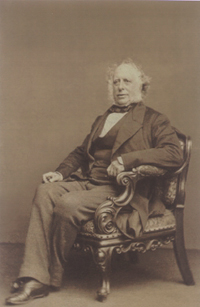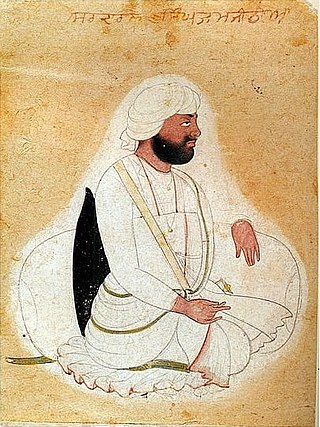| |||||
| Centuries: | |||||
|---|---|---|---|---|---|
| Decades: | |||||
| See also: | List of years in India Timeline of Indian history | ||||
Events in the year 1846 in India.
| |||||
| Centuries: | |||||
|---|---|---|---|---|---|
| Decades: | |||||
| See also: | List of years in India Timeline of Indian history | ||||
Events in the year 1846 in India.
The Treaty of Amritsar, executed by the British East India Company and Raja Gulab Singh of Jammu after the First Anglo-Sikh War, established the princely state of Jammu and Kashmir under the suzerainty of the British Indian Empire.

The First Anglo-Sikh War was fought between the Sikh Empire and the British East India Company in 1845 and 1846 around the Ferozepur district of Punjab. It resulted in defeat and partial subjugation of the Sikh empire and cession of Jammu & Kashmir as a separate princely state under British suzerainty.

The Gilgit Agency was an agency within the British Indian Empire. It encompassed the subsidiary states situated at the northern border of the princely state of Jammu and Kashmir. The primary objective of establishing the Gilgit Agency was to bolster and fortify these regions, particularly in the context of concerns about Russian encroachment in the area. The subsidiary states encompassed Hunza, Nagar and other states in the present day districts of Gupis-Yasin, Ghizer, Darel, Tangir and Diamer. The agency headquarters was based in the town of Gilgit, which was itself under the direct administration of the Maharaja of Jammu and Kashmir.

The Sikh Empire was a regional power based in the Punjab region of South Asia. It existed from 1799, when Maharaja Ranjit Singh captured Lahore, to 1849, when it was defeated and conquered by the British East India Company in the Second Anglo-Sikh War. It was forged on the foundations of the Khalsa from a collection of autonomous misls. At its peak in the 19th century, the empire extended from Gilgit and Tibet in the north to the deserts of Sindh in the south and from the Khyber Pass in the west to the Sutlej in the east as far as Oudh. It was divided into four provinces: Lahore, which became the Sikh capital; Multan; Peshawar; and Kashmir from 1799 to 1849. Religiously diverse, with an estimated population of 4.5 million in 1831, it was the last major region of the Indian subcontinent to be annexed by the British Empire. Some of the notable Commander-in-Chief of the Sikh Empire were Misr Diwan Chand, Hari Singh Nalwa and Diwan Mokham Chand.

Maharaja Gulab Singh Jamwal (1792–1857) was the founder of Dogra dynasty and the first Maharaja of the princely state of Jammu and Kashmir, the largest princely state under the British Raj, which was created after the defeat of the Sikh Empire in the First Anglo-Sikh War. During the war, Gulab Singh stayed aloof which helped the British victory, and even became prime minister of the Sikh Empire for the final 38 days of conflict. The Treaty of Amritsar (1846) formalised the sale by the British to Gulab Singh for 7,500,000 Nanakshahee Rupees of all the lands in Kashmir that were ceded to them by the Sikhs by the Treaty of Lahore.

Majha is a region located in the central parts of the historical Punjab region split between India and Pakistan. It extends north from the right banks of the river Beas, and reaches as far north as the river Jhelum. People of the Majha region are given the demonym "Mājhī" or "Majhail". Most inhabitants of the region speak the Majhi dialect, which is the basis of the standard register of the Punjabi language. The most populous city in the area is Lahore on the Pakistani side, and Amritsar on the Indian side of the border.
The Treaty of Lahore of 9 March 1846 was a peace-treaty marking the end of the First Anglo-Sikh War. The treaty was concluded, for the British, by the Governor-General Sir Henry Hardinge and two officers of the East India Company and, for the Sikhs, by the seven-year-old Maharaja Duleep Singh and seven members of Hazara, the territory to the south of the river Sutlej and the forts and territory in the Jalandhar Doab between the rivers Sutlej and Beas. In addition, controls were placed on the size of the Lahore army and thirty-six field guns were confiscated. The control of the rivers Sutlej and Beas and part of the Indus passed to the British, with the proviso that this was not to interfere with the passage of passenger boats owned by the Lahore Government. Also, provision was made for the separate sale of all the hilly regions between River Beas and Indus, including Kashmir, by the East India Company at a later date to Gulab Singh, the Raja of Jammu.
Henry Lawrence's "Young Men", also known as "the Paladins of the Punjaub", were a group of East India Company officers sent to act as "advisers" to the Sikhs after the First Sikh War in 1846. In the words of George Lawrence, his duties were "to act as a friendly adviser to the native officials". They served under the command of Sir Henry Lawrence, initially the Agent to the Governor General and later also the Resident at Lahore.

The Dogra dynasty of Dogra Rajputs from the Shivalik hills created Jammu and Kashmir when all dynastic kingdoms in India were being absorbed by the East India Company. Events led the Sikh Empire to recognise Jammu as a vassal state in 1820, and later the British added Kashmir to Jammu with the Treaty of Amritsar in 1846. The founder of the dynasty, Gulab Singh, was an influential noble in the court of the Sikh emperor Maharaja Ranjit Singh, while his brother Dhian Singh served as the prime minister of the Sikh Empire. Appointed by Ranjit Singh as the hereditary Raja of the Jammu principality, Gulab Singh established his supremacy over all the hill states surrounding the Kashmir Valley. After the First Anglo-Sikh War in 1846, under the terms of the Treaty of Lahore, 1846, the British Indian government acquired Kashmir from the Sikh Empire and transferred it to Gulab Singh, recognising him as an independent maharaja. Thus, Jammu and Kashmir was established as one of the largest princely states in British India, receiving a 21-gun salute for its Maharaja in 1921. It was ruled by Gulab Singh and his descendants till 1947.

Attari, also spelled Atari, is a village of Amritsar district in the Punjab state of India, 3 km from the Indo-Pakistani border at Wagah. It is situated 25 km west of the Sikh holy city of Amritsar, and is the last Indian station on the rail route connecting Lahore, Pakistan with the Indian capital Delhi. Attari village was the native village of Sardar Sham Singh Attariwala, one of the generals in the Army of Maharaja Ranjit Singh.There is Virk green Farm at BusStand ,GT Road ,Owned by Dilbag Singh Attari,a Senior Criminal Defence lawyer of Punjab and Haryana High Court and District Courts,Amritsar.

Sir Frederick Currie, 1st Baronet was a British diplomat, who had a distinguished career in the British East India Company and the Indian Civil Service. His posts included Foreign Secretary to the Government of India, Member of the Supreme Council of India, Resident at Lahore and Chairman of the East India Company.

The Sikh Rule in Lahore initiated from the conquest and rule of the Sikh Misls and extended till the Sikh Empire of Ranjit Singh which ended in 1849. The Sikhs began gaining power following the decline of the Mughal Empire in Punjab and consisted of a collection of autonomous Punjabi Misls, which were governed by Misldars, mainly in the Punjab region.

The history of Azad Kashmir, a part of the Kashmir region administered by Pakistan, is related to the history of the Kashmir region during the Dogra rule. Azad Kashmir borders the Pakistani provinces of Punjab and Khyber Pakhtunkhwa to the south and west respectively, Gilgit–Baltistan to the north, and the Indian union territory of Jammu and Kashmir to the east.

The Afghan–Sikh Wars spanned from 1748 to 1837 in the Indian subcontinent, and saw multiple phases of fighting between the Durrani Empire and the Sikh Empire, mainly in and around Punjab region. The conflict's origins stemmed from the days of the Dal Khalsa, and continued after the Emirate of Kabul succeeded the Durrani Empire.

Raja Lal Singh was Wazir of the Sikh Empire and commander of Sikh Khalsa Army forces during the First Anglo-Sikh War. Along with Tej Singh, Lal Singh was in the employ of the East India Company during the course of the war. Lal Singh was regularly supplying information and even receiving instructions from Company officers, communicating through Captain Peter Nicholson.

Lehna Singh Majithia, his personal name is also romanized as Lahina or Lahna, was a Sher-Gill Jat polymath, inventor, warrior, and statesman. Lehna Singh was the father of famous businessman and philanthropist, Dyal Singh Majithia.

Tej Singh was a Sikh commander in the Sikh Empire. He was appointed as Commander in chief of the Sikh Khalsa Army during the First Anglo-Sikh War.
The Treaty of Amritsar may refer to:

Raja Dhian Singh was the longest serving wazir of the Sikh Empire, during the reign of Maharajah Ranjit Singh, and four of his successors. He held the office for twenty five years, from 1818 up till his death. Dhian Singh was a brother of Raja Gulab Singh of Jammu, who later founded the Dogra dynasty when he became Maharaja of the princely state of Jammu and Kashmir under the British Raj. Another brother Suchet Singh also served the empire. The three brothers were collectively known as the "Dogra brothers" in the Sikh empire, based on their ethnicity.